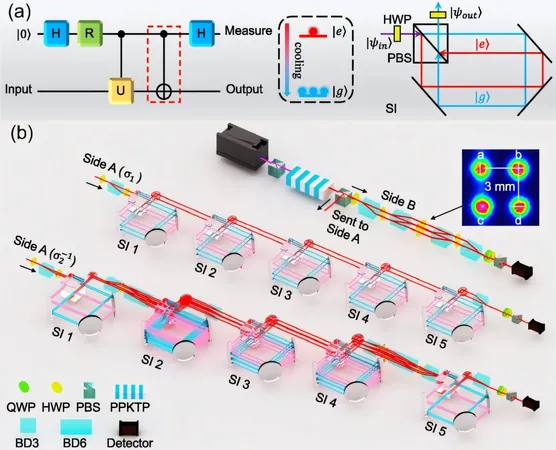
Breakthrough in Quantum Computing: Majorana Zero Modes Unlock New Potential for Jones Polynomial Calculations!
2024-12-30
Author: Jacob
Introduction
In a groundbreaking study published in Physical Review Letters, a team of researchers has made significant strides in the field of quantum computing by experimentally calculating the Jones polynomial through the simulation of braided Majorana zero modes (MZMs). This monumental achievement showcases the power of quantum simulations in exploring complex topological properties, which could have far-reaching implications for multiple scientific disciplines.
The Significance of Jones Polynomial
The Jones polynomial functions as a vital tool for determining whether two knots are topologically equivalent—an area that has captivated mathematicians and physicists alike. Its significance extends into various fields, including DNA biology and condensed matter physics, igniting a growing interest in understanding and approximating these polynomials. However, the challenge lies in the computational complexity involved; computing the Jones polynomial is classified within the #P-hard complexity class, making traditional algorithms inefficient due to their exponential resource demands.
Quantum Simulation and Majorana Zero Modes
Enter quantum simulation! This innovative approach allows for the experimental investigation of non-Abelian anyons—particles that could revolutionize quantum computing. Majorana zero modes, considered one of the most promising candidates for realizing non-Abelian statistics, were put under the microscope by this research team using a sophisticated photonic quantum simulator. By exploiting two-photon correlations and nondissipative imaginary-time evolution, the researchers performed intricate braiding operations on MZMs, effectively generating anyonic worldlines of various links.
Experimental Results and Innovations
Their results were remarkable. They successfully simulated the exchange operations of a single MZM within a Kitaev chain and even explored the non-Abelian geometric phase of MZMs in a two-Kitaev chain model. This was further extended to include high-dimensional semion zeroth modes, where the braiding processes exhibited remarkable resilience to local noise and preserved essential quantum contextual resources.
The researchers enhanced their methodologies by transitioning from single-photon to dual-photon spatial encoding, leveraging coincidence counting of dual photons to expand the quantum states that can be encoded. This innovative approach significantly increased the capability of their quantum simulator. Through the implementation of a Sagnac interferometer-based quantum cooling device, they transformed dissipative evolution into nondissipative processes, optimizing the use of photonic resources and allowing for multi-step quantum evolution operations.
Fidelity and Topological Knot Simulations
Impressively, the team's experimental setup demonstrated an average fidelity of over 97% in realizing the desired braiding operations—a testament to the precision of their work. By employing various braiding operations across three Kitaev chain models, they successfully simulated five distinct topological knots and derived their corresponding Jones polynomials, effectively distinguishing between topologically inequivalent links.
Implications and Future Directions
This research is more than just an academic exercise; it paves the way for advancements in statistical physics, molecular synthesis, and integrated DNA replication, where the understanding of complex topological knots can lead to breakthroughs in processing and manipulating biological materials.
As the quest to unravel the mysteries of quantum computing continues, this study represents a giant leap forward. Are we on the brink of a new era in quantum technology? Only time will tell, but the implications of this research are, without a doubt, monumental.









 Brasil (PT)
Brasil (PT)
 Canada (EN)
Canada (EN)
 Chile (ES)
Chile (ES)
 Česko (CS)
Česko (CS)
 대한민국 (KO)
대한민국 (KO)
 España (ES)
España (ES)
 France (FR)
France (FR)
 Hong Kong (EN)
Hong Kong (EN)
 Italia (IT)
Italia (IT)
 日本 (JA)
日本 (JA)
 Magyarország (HU)
Magyarország (HU)
 Norge (NO)
Norge (NO)
 Polska (PL)
Polska (PL)
 Schweiz (DE)
Schweiz (DE)
 Singapore (EN)
Singapore (EN)
 Sverige (SV)
Sverige (SV)
 Suomi (FI)
Suomi (FI)
 Türkiye (TR)
Türkiye (TR)
 الإمارات العربية المتحدة (AR)
الإمارات العربية المتحدة (AR)